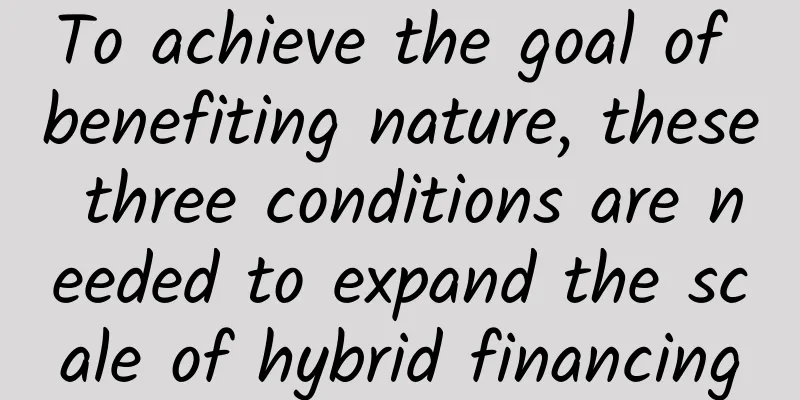To achieve the goal of benefiting nature, these three conditions are needed to expand the scale of hybrid financing

“Without action to protect and restore nature, it will be impossible to limit global warming to 1.5 degrees Celsius,” the four architects of the Paris Agreement wrote ahead of the 15th Conference of the Parties to the United Nations Convention on Biological Diversity last December. “Only by taking action now to build a nature-enabled society can we achieve net zero emissions by 2050.” Building a world where nature benefits and expanding climate finance flows by at least 590% to achieve global climate goals by 2030 will require mobilizing significant resources. Blended finance, which uses public or philanthropic funds to boost private investment, will become an important source of financing for nature conservation. It is also particularly important to fill the $700 billion annual biodiversity financing gap . Kunming - The Montreal Global Biodiversity Framework has taken strong action to scale up financing for nature, aiming to halt and reverse biodiversity loss and put nature on a path to recovery. The Exponential Roadmap to Natural Climate Solutions, published by Conservation International, outlines a path to achieve net zero emissions from land use by 2030 through natural climate solutions. These solutions achieve the goal by protecting existing ecosystems, sustainably managing cropland, and restoring degraded forests and wetlands. While some emission reduction solutions are already cost-effective at less than $100 per ton, we still need major changes in the global financial system to achieve the goal. Therefore, it is important to create favorable conditions for hybrid financing to expand rapidly. Expanding financing through diversified alliances First, we must build ambitious coalitions to finance key biodiversity areas. Ambition coalitions that work with different types of international entities and leverage the participation of the global North and the global South are essential to accelerate action and scale up financing to achieve our shared goal of protecting nature. In this regard, the Like-Minded Megadiverse Countries, a coalition of 17 countries, may have a greater impact than any single country. The Global Fund for Coral Reefs is a coalition of UN agencies, countries, philanthropies, private investors and institutions that aims to address the threat of rising global temperatures to the world's remaining coral reef populations. This 10-year, $625 million blended financing instrument aims to strengthen conservation efforts to protect fragile coral ecosystems. It is a powerful example of the positive impact that biodiversity alliances can achieve. Alliances are also key to ensuring no group is left behind. Indigenous peoples make up just 6% of the global population , but are closely tied to protecting 80% of the world’s biodiversity . A recent Conservation International paper on the drivers of deforestation shows that indigenous-led management is key to slowing deforestation. Despite their role as guardians of nature, indigenous peoples and local communities receive little support in global environmental funding. Alliances with actors that prioritize the engagement of indigenous peoples and local communities will help shift financial flows toward community-led conservation efforts. According to the World Economic Forum , embedding traditional ecological knowledge in nature-based solutions and making indigenous peoples leaders of co-investment is not only valuable for corporate actions on nature conservation, but also beneficial for the long-term health of nature. Mainstreaming nature issues in multilateral development banks Second, nature must be mainstreamed into the operations and policies of multilateral development banks (MDBs) to scale up blended finance. Since the launch of the Bridgetown Initiative and the New Global Financing Deal Summit last June , the international community has made it a priority to enable MDBs to effectively address the interconnected crises facing the South this century. Last year's resolution at the 15th Conference of the Parties to the United Nations Convention on Biological Diversity also called on multilateral development banks and other international financial institutions to participate in the design and operation of the Global Biodiversity Framework Fund of the Global Environment Facility (GEF). We are already seeing MDBs taking a leading role in developing blended finance instruments. The World Bank’s Wildlife Conservation Bond will issue a $150 million linked bond that leverages grant financing from the Global Environment Facility and private investment to protect endangered black rhino populations, tying investor returns to the rhino’s growth rate. The Global Fund for Coral Reefs leverages MDBs and the Green Climate Fund to help unlock adaptation finance for coral reefs. Solid foundation Third, isolating climate and biodiversity finance from political and economic fluctuations is key. For example, elections can change the political will to provide finance for nature to address the dual crises of biodiversity and climate. Economic recessions and corporate budget cuts often affect sustainable investments. Standardized instruments and procedures must be institutionalized through strong national policies to continuously release finance for nature. The structure of funding mechanisms can also be resilient. The Global Coral Reef Fund draws on funding from a diverse group of stakeholders, including the governments of Germany, Canada, France and the United Kingdom. By working with multiple member states, multilateral institutions and the private sector, the Global Coral Reef Fund is less dependent on a single actor and more adaptable to changing political situations in different countries. These daunting challenges to fill the gaps in climate finance and biodiversity finance present an excellent opportunity for blended finance and other innovative mechanisms to catalyze public, private and philanthropic investments. These three enabling conditions will help unlock the potential of blended finance to achieve the 2030 climate and biodiversity goals. Author of this article: Akanksha Khatri, Head of Nature and Biodiversity, World Economic Forum Carlos Correa, Senior Researcher at Conservation International This article originally appeared on the World Economic Forum's Agenda blog |
<<: [A magic tool for watching movies anytime, anywhere] PaPa Pocket Cinema Review
>>: Win10 mobile preview version is online: only a few devices are supported
Recommend
The human gene pool has a "new member"! Chongqing researchers discovered a new allele for the first time and were named by the World Health Organization
On July 7, a reporter from Chongqing Daily learne...
Advanced Operations: How to use 4P theory to achieve growth?
As we all know, operations are divided into produ...
Tik Tok promotion and operation methodology: 3 major principles and 6 major positioning methods!
First of all, from the perspective of short video...
How should different industries choose information flow platforms? Take this report for reference!
2017 is still a period of rapid development for i...
Xpeng Motors: In June 2024, Xpeng Motors' deliveries reached 10,668 units, a year-on-year increase of 24%.
We learned from Xiaopeng Motors that its deliveri...
WeChat 8.0 has been updated! Let’s talk about the subtle details of the experience design
These days, WeChat 8.0 has completely dominated t...
Two trends and 10 key points for future online marketing
From the era without Internet to the era of click...
What is the lunar calendar date for Spring Festival 2022? What specific day is it? Is it March 21st?
There are many customs that have been passed down...
"Intelligent Connected Vehicle Technology Roadmap 2.0" released! Juefei Technology takes the lead in realizing the large-scale implementation of the vehicle-road-cloud industry
Recently, the "2020 World Intelligent Connec...
Yuanfudao Children's Programming Course L1+L2
LEVEL1 Course Content Introduction Based on face ...
A complete operation and promotion plan for an App!
1. Concept of App operation and promotion Quoting...
Xiaomi Youpin Product Analysis Report
Boutique e-commerce is different from traditional...
Bao Juncheng: ATA All-round Literacy - Reading Chinese Stories (A)
A unique learning dimension: explaining Chinese s...
[Practical Tips] Tencent Senior Product Manager: Talking about Operations with Seven Emotions and Six Desires
Chen Tingting, who has 8 years of experience in I...
Online customer acquisition skills, share these 3 steps!
Before I start, I would like to ask you if you ha...









